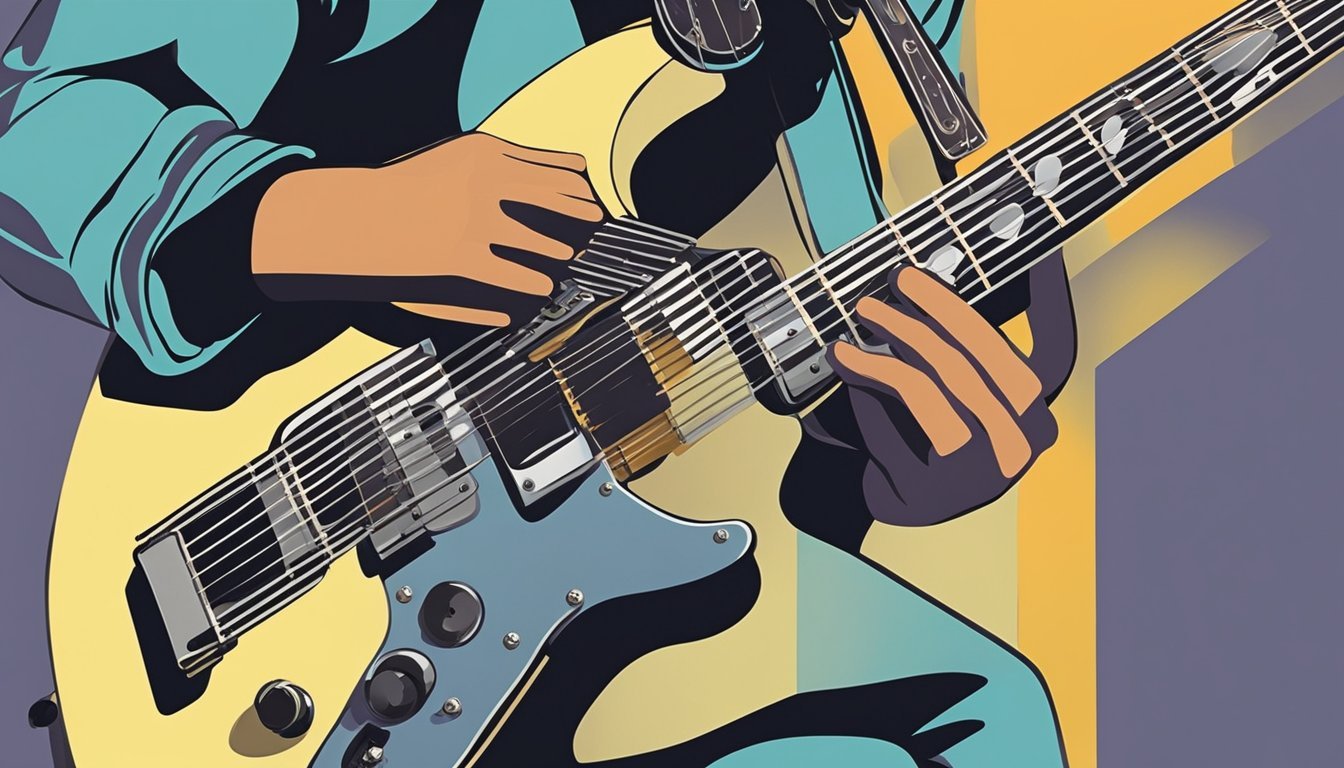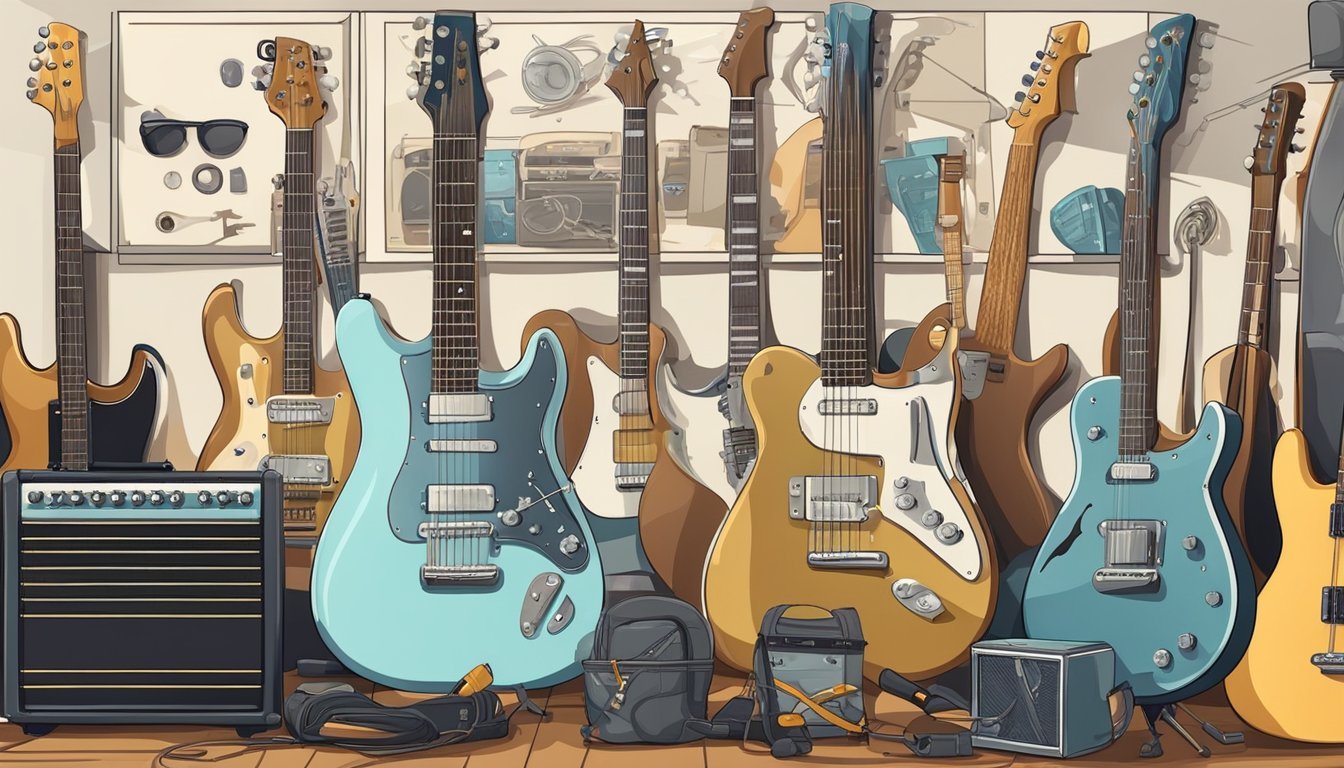Learning to play the electric guitar opens up a world of possibilities for music lovers.
To get started, familiarize yourself with the parts of your guitar and basic techniques like holding the instrument and strumming effectively.
With some practice and patience, you can unlock your musical potential and express yourself through this versatile instrument.

As you progress, exploring different styles and techniques will keep your journey exciting.
Don’t forget that regular practice is key to improving your skills.
Whether you’re strumming along to your favorite songs or creating your own riffs, you’ll find joy in every step.
Key Takeaways
- Understanding your guitar’s parts helps you play better.
- Regular practice leads to noticeable improvement.
- Exploring different styles keeps your learning fresh and fun.
Getting Started with Your Electric Guitar
Getting started with your electric guitar is exciting! You’ll want to know your instrument well, gather essential gear, learn how to hold your guitar, and make sure it’s in tune.
Understanding these basics makes learning easier and more enjoyable.
Understanding Your Guitar
Your electric guitar has several key parts.
The body is the large part that amplifies sound.
The neck holds the fretboard, where you press down the strings to create notes.
You’ll find the pickups, which capture the vibrations of the strings and send them to the amplifier.
Next, the bridge holds the strings in place and helps with tuning.
Knowing these parts will help you understand how to play better and what each part does.
Essential Gear
Besides your electric guitar, you’ll need some essential gear.
First, get a guitar tuner to keep your guitar sounding great.
A clip-on tuner is easy to use.
You should also have guitar picks.
They come in different thicknesses, so you can find what feels best for you.
An amplifier is important next, as it makes your guitar louder.
Don’t forget a cable to connect your guitar to the amp, and a strap to help you play comfortably while standing.
Holding the Guitar
When holding the guitar, make sure you’re comfortable.
Sit up straight in a chair, or stand with your feet shoulder-width apart.
If you’re sitting, rest the body of the guitar on your right leg (if you’re right-handed).
Your left hand should be on the neck, ready to fret the strings.
Use your right hand to hold the pick or fingers over the strings.
Finding a comfortable grip makes it easier to play.
Tuning Your Guitar
Before you start playing, you need to tune your guitar.
Using a guitar tuner is one of the easiest ways.
Clip it onto the headstock and pluck each string.
The tuner will tell you if the string is too high or too low.
If the sound is off, adjust the tuning pegs until it matches the correct pitch.
Make it a habit to check your tune often, especially before practice sessions or performances.
A well-tuned guitar makes a big difference in how you sound!
Basic Guitar Techniques
When starting out with the electric guitar, mastering a few basic techniques can make a big difference.
You’ll learn about finger placement for chords, how to strum effectively, and even play your first song.
Let’s dive into these essential skills.
Finger Placement and Chords
Getting your finger placement right is crucial.
Start with basic guitar chords like the E minor chord, C chord, D chord, G chord, A chord, and B chord.
Press down on the strings with your fingertips, as this helps avoid muted sounds from other strings.
Try placing your fingers close to the frets without actually touching them.
This gives you a cleaner sound.
Practice changing between chords to get comfortable.
Focus on common chord progressions, such as C-G-Am-F, which you’ll find in many songs.
Strumming Basics
Strumming patterns are key for any guitarist.
Learn the difference between a downstroke and an upstroke.
A downstroke hits the strings from the top down, while an upstroke goes the opposite way.
Start with basic guitar strumming patterns like down, down, up, up, down.
Repeat this until it feels natural.
Remember, consistency is more important than speed.
Use a metronome to keep your timing steady.
Don’t forget to relax your wrist for smoother movements and better control.
Playing Your First Song
Now comes the fun part—playing your first song! Choose a simple song that uses the beginner chords you’ve learned, like “Three Little Birds” by Bob Marley.
Break the song down into sections and practice each part slowly.
You can use the chords you already know and apply your strumming patterns.
This makes it easier to follow along.
As you progress, try to incorporate different chord progressions and strumming patterns to add variety.
Playing along with the original track can help you stay in time and make it more enjoyable.
Improving Your Skills
To become a better electric guitar player, focus on developing specific techniques.
Mastering scales, practicing strumming patterns, and experimenting with effects will take your playing to the next level.
Let’s break down how to improve in each area.
Scales and Soloing Techniques
Understanding scales is key when you want to improvise or create solos.
Start with the major and minor scales, which are the foundation of the musical alphabet.
You can practice scales by using hammer-ons and pull-offs.
These techniques make your playing sound smoother and more fluid.
For example, try playing a scale, using a hammer-on from the first to the second note, and then a pull-off back to the first.
This will help you develop speed and agility.
Additionally, try to incorporate these scales into your favorite guitar songs to make practice more enjoyable.
Finding creative ways to use scales in the context of rock music will also enhance your soloing skills.
Advanced Strumming
Once you’re comfortable with basic strumming, challenge yourself with advanced patterns.
Start by learning syncopation, where you emphasize weak beats to create a more dynamic sound.
You might also experiment with muted strumming, where you lightly rest your palm on the strings while you strum.
This creates a percussive sound that can add depth to your rhythm playing.
Make a list of songs that use different strumming patterns and learn them.
This will not only improve your skills but will boost your confidence when playing with others.
Don’t forget to practice along with a metronome.
This helps you keep your timing tight.
Using Guitar Effects
Guitar effects can really change your sound.
Start with a few basic pedals, like distortion and overdrive, which are popular in rock music.
Experimenting with these effects will show you how different sounds can transform your playing style.
For example, use distortion to create a heavier sound for rock songs and switch to a cleaner tone for ballads.
Add in effects like reverb or delay to give your playing more atmosphere.
Try layering effects while playing scales or songs.
This experimentation can lead to a unique tone that represents your style.
Enjoy discovering how effects can enhance your music!
Exploring Guitar Styles and Maintenance

When playing the electric guitar, understanding different styles and how to care for your instrument is essential.
This knowledge will enhance your skills and extend the life of your guitar.
Guitar Genres
There are many guitar genres to explore.
Each has its own sound and techniques.
- Rock: Think of legends like Eric Clapton and the Rolling Stones. Their music often features powerful riffs and expressive solos.
- Blues: This genre is known for its emotional depth. You’ll often use techniques like bends and slides.
- Jazz: Here, improvisation is key. You can explore complex chords and unique rhythms.
Finding your preferred genre helps you focus your practice.
Consider taking online guitar lessons to dive deeper into these styles with expert guidance.
Caring for Your Guitar
To keep your electric guitar in top shape, follow these maintenance tips:
- Regular Cleaning: Wipe down your guitar after each use. Use a soft cloth to clean the strings and body to remove oils and grime.
- String Changes: Change your strings regularly. Old strings can sound dull. Experiment with different brands to find your favorites.
- Humidity Control: Store your guitar in a suitable environment. Keeping it at the right humidity prevents damage to the wood.
Caring for your instrument ensures it sounds great when you play your favorite riffs or strum along to classics.
Frequently Asked Questions
Learning to play electric guitar can feel overwhelming, but starting with the right steps makes it easier.
You might be curious about self-learning, essential chords, effective practice methods, and useful tips for beginners.
Here are some answers to your most common questions.
What are the first steps to learning electric guitar for beginners?
Begin by getting familiar with your electric guitar.
Learn the names of the parts, such as the body, neck, and pickups.
Start tuning your guitar.
A proper tune is crucial for sounding good.
Once that’s done, you can practice simple strumming patterns and basic notes.
As you progress, focus on learning basic chords and transitioning between them smoothly.
This will build your finger strength and dexterity, which are essential for more advanced techniques.
If you’re serious about how to master electric guitar, consider setting aside dedicated practice time each day to enhance your skills and become more comfortable with your instrument.
Can you learn electric guitar by yourself, and if so, how?
Yes, you can absolutely learn electric guitar by yourself! Use online resources, video tutorials, and apps designed for beginners.
Start with simple lessons to grasp the basics.
Regular practice is key, so set aside time each day to build your skills.
What are some basic electric guitar chords every beginner should know?
Every beginner should learn a few essential chords like E minor, A major, and D major.
These chords are the building blocks for many songs.
Practicing these regularly will help you get comfortable with finger positioning and transitions.
How do you practice playing electric guitar effectively?
Practice smart by setting specific goals.
Focus on one skill at a time, like strumming or chord changes.
Use a metronome to improve your timing.
Short, daily practice sessions are often more effective than long, infrequent ones.
Is it possible to learn electric guitar for free, and where can I find resources?
Yes, you can learn electric guitar for free.
Many websites, YouTube channels, and apps offer tutorials and lessons.
You can find beginner courses or instructional videos to get started without spending a dime.
Are there any handy tips for absolute beginners starting to play electric guitar?
Starting slow and staying patient with yourself is important.
Don’t be afraid to make mistakes; they’re part of learning.
Regularly change your practice routines to keep things fresh and fun.
Lastly, try playing along with your favorite songs to stay motivated and improve your skills.

